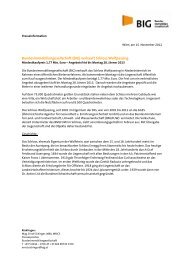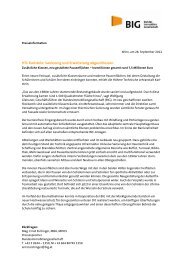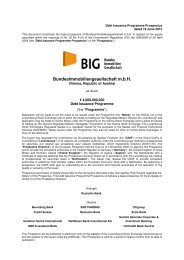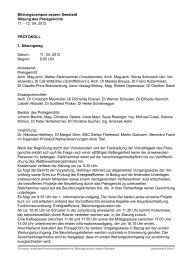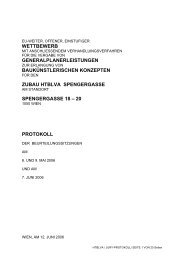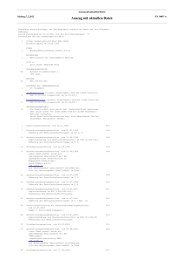Bundesimmobiliengesellschaft m.b.h. - BIG
Bundesimmobiliengesellschaft m.b.h. - BIG
Bundesimmobiliengesellschaft m.b.h. - BIG
Create successful ePaper yourself
Turn your PDF publications into a flip-book with our unique Google optimized e-Paper software.
This Analysis provides a discussion of the factors underpinning the<br />
credit rating/s and should be read in conjunction with our Credit<br />
Opinion. The most recent ratings, opinion, and other research specific<br />
to this issuer are provided on Moodys.com. Click here to link.<br />
<strong>Bundesimmobiliengesellschaft</strong> m.b.H.<br />
Analysis<br />
Key factors driving the Aaa rating of <strong>Bundesimmobiliengesellschaft</strong> (<strong>BIG</strong>) are its 100% ownership by the Republic of<br />
Austria (rated Aaa), the strategic importance of the services provided and its financial ties to the State. <strong>BIG</strong>'s activities<br />
are chiefly government-related, entailing the administration and management of properties required by the state to<br />
carry out its functions, predominantly schools, university buildings and ministry premises. As such, <strong>BIG</strong>'s activity is<br />
therefore less vulnerable to volatile demand and the bulk of its revenues come from the State in the form of rents.<br />
Although <strong>BIG</strong>'s stand-alone financials are less sound than those of a comparable private sector entity, its closeness to<br />
the State and State functions strongly mitigate this factor. I think State starts in capital letter.<br />
Business Franchise<br />
Contact Phone<br />
July 2004<br />
London<br />
Janne Thomsen 44.20.7772.5454<br />
Gabriele Baur<br />
New York<br />
Yves J Lemay 1.212.553.1653<br />
BACKGROUND<br />
<strong>BIG</strong> has responsibility for managing the Austrian Republic's real estate, with a portfolio predominated by schools and<br />
universities (72%) and other administrative buildings (28%). <strong>BIG</strong>'s activities involve renting out the buildings to the<br />
various government entities, carrying out renovations and new investments and handling possible sales of redundant<br />
buildings and land. <strong>BIG</strong>'s holdings include a small housing portfolio, comprising mainly the current and former homes<br />
of civil servants and other public sector employees. Finally, <strong>BIG</strong> offers facilities management services if required by the<br />
tenants. <strong>BIG</strong> consists of a holding company, <strong>Bundesimmobiliengesellschaft</strong> mbH (<strong>BIG</strong>) and three subsidiaries — <strong>BIG</strong><br />
Services, <strong>BIG</strong> Bauträger und Maklerges MbH and <strong>BIG</strong> Liegenchaftsverwertungsges BmH- 100% owned by <strong>BIG</strong> and consolidated<br />
into <strong>BIG</strong>'s accounts. This report focuses on the consolidated accounts.<br />
THE PURPOSE OF <strong>BIG</strong>'S CREATION WAS TO IMPROVE EFFICIENCY<br />
<strong>BIG</strong> was created by law in 1992 with the objective of centralising the property management of the public sector, making<br />
it more efficient and, more importantly, trying to make the various departments more cost-conscious. The underlying<br />
premise is that if departments are obliged to pay and account for their usage of buildings, space will only be used<br />
if really needed. This should in theory allow surplus stock to be put to alternative use or sold off.<br />
AS OF BEGINNING OF 2001, <strong>BIG</strong> STARTED TO OWN THE PROPERTIES<br />
Following a revision of the act regulating <strong>BIG</strong>'s activities 2000, the entity now owns the properties previously leased<br />
from the state. The purchase price was set at €2.4 billion, with the transfer being completed during 2003. The purchase<br />
was financed with debt.
PRICE FOR THE TRANSFERRED ASSETS IS DEEMED FAIR<br />
Moody's views €2.4 billion as a fair price for the transferred assets. According to an independent valuation of the properties<br />
by the Technische Universität Wien, the market value is €6.9 billion. The lower transfer value takes into account<br />
the specialist nature of the properties — i.e. they possibly have a lower re-sale value — and future investment needs.<br />
Moreover, should <strong>BIG</strong> ever sell any of the transferred assets in the future with a positive margin over the purchase<br />
price, the entity would then have to pay a share of the gain to the state, i.e. a formulaic calculation of the share, taking<br />
into account the gain on disposal. This would equate to paying out around 70% of the capital gain.<br />
STATE OWNERSHIP STRONGLY SUPPORTS RATING<br />
The 100% ownership of <strong>BIG</strong> by the Republic of Austria provides comfort that the owner will:<br />
• Support the entity in the event of a problem arising<br />
• Remain the main tenant of <strong>BIG</strong>, and hence provide revenue/margin stability<br />
• Determine policy (tasks and obligations) of the entity going forward, while taking financial stability into<br />
account<br />
• Supervise and control the activities of <strong>BIG</strong><br />
The State's ownership could only be reduced below 100% through a change in the law pertaining to <strong>Bundesimmobiliengesellschaft</strong>.<br />
Although this is not impossible, to date the Austrian State has signalled no intention of effecting<br />
such a change, as <strong>BIG</strong> is regarded as a vital instrument in the management of the State's properties. <strong>BIG</strong>'s accounts are<br />
audited by the Federal Audit Office.<br />
Furthermore, there are no plans to extend the entity's activities to the private sector to a material degree.<br />
Although the law in question allows for <strong>BIG</strong> to carry out commercial property marketing and development, such activities<br />
are supposed to be of a subsidiary nature and there are currently no plans to expand commercial activities beyond<br />
asset sales of surplus or unused properties and land.<br />
Financial Fundamentals<br />
2003 RESULTS IN LINE WITH PREVIOUS YEARS<br />
<strong>BIG</strong>'s after-tax results fell by almost 3% to €59 million in 2003 from €61 million in 2002; however, they remained positive.<br />
Although operating revenue growth outstripped that of operating expenditure by 2%, <strong>BIG</strong>'s increasing funding<br />
costs from taking over properties from the central government during the year resulted in a slightly lower profit.<br />
RENTAL INCOME AND BUILDINGS OCCUPANCY<br />
Rental income is the mainstay of <strong>BIG</strong>'s income, representing more than 90% of total operating revenues. Of this, 95%<br />
comprises rents received from the state - i.e. from various ministries that use the buildings. The Federal Ministry for<br />
Education accounts for the majority (67%) of <strong>BIG</strong>'s rental income in the form of schools and universities, followed by<br />
other Federal Tenants (27% each) and other Tenants (6%) (see Figure I: 2003 Property Occupancy Breakdown of total<br />
book value €3,940 billion). Rents are paid monthly or quarterly for all properties, whereas housing rents are paid monthly.<br />
2 Moody’s Analysis<br />
2003 Property Occupancy Breakdown of total book value (€3,940 billion)<br />
Ministry of Finance<br />
6%<br />
Other Ministries<br />
5%<br />
Ministry of internal<br />
Affairs<br />
7%<br />
Third Party Tenants<br />
3%<br />
Ministry of Justice<br />
7%<br />
Ministry for Education<br />
72%
There are options for giving notice under the rental agreements; the notice period is one year for tenants, covering<br />
70% of the total revenue. However, the tenants are deemed to be relatively stable, since the ministries need the<br />
properties as a base from which to provide services such as education. The notice periods for new projects or major<br />
renovations benefit from a clause that forbids the tenant from giving notice during the debt amortisation period (usually<br />
20-25 years).<br />
RENT LEVELS TAKE INTO ACCOUNT A REASONABLE MARGIN AND THE NEED FOR INVESTMENT<br />
Rents have been fixed on a market basis, while taking into account the relatively specialised nature of the properties,<br />
and as of 2003 indexed to a designated consumer price index with a one-year lag (currently CPI 1996). Adjustments are<br />
only allowed if they are 5% above this index, and the adjustment will then be in full. As such, the potential for rental<br />
increases is not considered to be particularly flexible. During 2003, rental income grew by 1%, considerably below the<br />
4.5% achieved the previous year, although this was in line with budget.<br />
COST KEPT UNDER CONTROL<br />
<strong>BIG</strong>'s management is focused on cost efficiency and project management, and has been successful in keeping operating<br />
costs at an acceptable level. We expect the prudent cost management to continue. Cost control of projects also<br />
includes joint-venture activities at <strong>BIG</strong>'s subsidiaries. Some savings have also taken place due to reductions in personnel<br />
costs, in connection with restructuring of the companies.<br />
GOING FORWARD<br />
Total consolidated results are expected to remain positive but considerably lower than in 2003, given that financial<br />
expenditure is projected to grow at an average rate of 8% during the period to an average nominal amount of €30 million<br />
per annum. According to <strong>BIG</strong>'s latest long-term plans, growth in rental income is expected to grow at a compound<br />
rate of 6.5% over the next five years. Other income — among other arising from the disposal of propertiesremains<br />
slightly more unstable due to its very nature, but is still expected to represent around 10% of total operating<br />
revenues.<br />
DEBT GROWTH EXPECTED TO BE MODERATED<br />
<strong>BIG</strong>'s stock of debt has risen relatively rapidly since 2000 as a result of the entity having taken over properties from the<br />
central government. Based on <strong>BIG</strong>'s long-term budgets, debt is not expected to grow considerably as it is believed to<br />
have reached its growth peak in 2004 at around €3.7 billion.<br />
€ million<br />
4.0<br />
3.5<br />
3.0<br />
2.5<br />
2.0<br />
1.5<br />
1.0<br />
0.5<br />
-<br />
2001<br />
2002<br />
2003<br />
Debt Developments<br />
2004 Budget<br />
2005 Estimated<br />
2006 Estimated<br />
2007 Estimated<br />
2008 Estimated<br />
Maturity profiles appear reasonably stable, with more than 64% of the total stock of debt having five years or<br />
more to maturity and, of the remainder in 2003, an acceptable 30% falling due within one year. Around 89% of the<br />
total debt is euro-denominated, with the balance in Swiss francs. Interest rate stability is afforded by the fact that over<br />
72% of the total stock is in fixed rates. <strong>BIG</strong> makes use of financial derivatives in order to hedge interest and currency<br />
exposures. The entity has acceptable prudent counterparty guidelines in place.<br />
Moody’s Analysis 3
OVERALL ADEQUATE LIQUIDITY PROFILE<br />
<strong>BIG</strong>'s cash flows are predictable— i.e. 90% of the rental income (mainstay of <strong>BIG</strong>'s income) comes from the State and<br />
are paid quarterly. Cash outflows, mostly, project financing and debt servicing, are also predictable. Mismatches are<br />
funded via <strong>BIG</strong>'s Euro Commercial Programme (rated P-1) of €1 billion of which in average approx. €114 million were<br />
drawn in 2003 (11% of the total). This amount ranged from a minimum of 0 to a maximum of around €200 million at<br />
any given day. In addition to this, <strong>BIG</strong> uses short term drawing rights with banks. No back up facilities are in place, yet<br />
the predictable nature of <strong>BIG</strong>'s cash-flows and its closeness to the Austrian government are mitigating factors.<br />
Related Research<br />
Banking System Outlook:<br />
Banking System Outlook: Austria, December 2003 (80700)<br />
Analysis:<br />
Austria, October 2003 (79706)<br />
Special Comments:<br />
Moody’s Sovereign Ratings: A Ratings Guide, March 1999 (43788)<br />
A Quantitative Model for Local Currency Government Bond Ratings, September 2003 (79404)<br />
A Quantitative Model for Foreign Currency Government Bond Ratings, February, 2004 (81176)<br />
Rating Methodology:<br />
Revised Country Ceiling Policy, June 2001 (67679)<br />
To access any of these reports, click on the entry above. Note that these references are current as of the date of publication of this report<br />
and that more recent reports may be available. All research may not be available to all clients.<br />
4 Moody’s Analysis
Bundesimmobliengesellschaft Mbh<br />
Summary Balance Sheet (EUR 000's) 12/31/96 12/31/97 12/31/98 12/31/99 12/31/00 12/31/01 12/31/02 12/31/03<br />
Cash & central bank 14,360 38,488 48,196 12,159 3,502 40 3,675 18,181<br />
Due from banks 0 0 0 0 0 0 0 0<br />
Securities 5,748 0 0 0 0 0 0 0<br />
Gross loans 0 0 0 0 0 0 0 0<br />
Loan loss reserves (LLR) 0 0 0 0 0 0 0 0<br />
Fixed assets 739,912 1,215,653 1,282,624 1,334,779 1,976,404 2,817,593 3,614,492 4,025,940<br />
Other assets 104,314 35,431 19,904 39,162 86,374 127,830 116,316 101,185<br />
Total assets 864,333 1,289,572 1,350,724 1,386,100 2,066,280 2,945,463 3,734,482 4,145,307<br />
Total assets (USD million) 862,348 1,448,306 1,438,710 1,382,918 2,061,536 2,938,701 3,977,747 4,655,556<br />
Demand deposits 0 0 0 0 0 0 0 0<br />
Savings deposits 0 0 0 0 0 0 0 0<br />
Due to banks 88,353 52,368 76,070 62,313 327,602 570,641 404,602 405,855<br />
Market funds 0 0 0 0 0 0 0 0<br />
Other liabilities 176,092 285,007 247,015 233,004 135,792 408,731 415,919 430,692<br />
Total liabilities 850,020 1,276,398 1,321,288 1,334,923 1,808,357 2,589,665 3,411,321 3,823,290<br />
LT/Subordinated debt 585,576 939,023 998,203 1,039,606 1,344,963 1,610,293 1,547,983 1,298,627<br />
Shareholders' equity 14,312 13,174 29,436 51,177 257,923 355,798 323,161 322,016<br />
Total Liabilities+Shareholders' equity 864,333 1,289,572 1,350,724 1,386,100 2,066,280 2,945,463 3,734,482 4,145,307<br />
Summary Income Statement (EUR 000's)<br />
+Interest income 155,957 194,863 249,824 260,037 292,927 677,073 697,229 680,634<br />
-Interest expense 19,613 92,429 97,090 102,628 140,128 331,653 416,952 431,298<br />
=Net interest income 136,344 102,434 152,734 157,409 152,799 345,420 280,277 249,336<br />
+Trading income 0 0 0 0 0 0 0 0<br />
+Fees & commissions 0 0 0 0 0 0 0 0<br />
+Other operating income 530 123 57 38 156 7,881 6,088 58,401<br />
=Operating income 136,873 102,557 152,791 157,447 152,955 353,301 286,365 307,737<br />
-Personnel expenses 1,893 2,170 2,395 2,398 3,142 12,294 13,366 16,241<br />
-Other operating expenses 97,224 42,250 76,887 76,839 69,675 80,311 17,888 20,551<br />
= Operating funds flow 37,756 58,137 73,509 78,210 80,138 260,696 255,110 270,945<br />
-Amortisation/depreciation 25,435 49,888 56,419 60,617 64,925 118,871 150,101 164,715<br />
=Preprovision income (PPI) 12,321 8,249 17,090 17,593 15,213 141,825 105,009 106,231<br />
-Loan loss provisions (LLP) 0 0 0 0 0 0 0 0<br />
+Other non operating adjustments [1] 195 3,209 413 382 565 354 366 -2,116<br />
+Extraordinary profit / loss 0 0 0 0 0 -11,142 1,116 0<br />
=Pretax income 12,516 11,458 17,503 17,975 15,778 131,037 106,492 104,114<br />
-Taxes -4,110 0 1,954 3,200 403 47,833 45,970 45,514<br />
=Net income 16,626 11,458 15,549 14,775 15,375 83,204 60,522 58,601<br />
-Minority interests 0 0 0 0 0 0 0 0<br />
=Net income (group share) 16,626 11,458 15,549 14,775 15,375 83,204 60,522 58,601<br />
Real Growth Rates (Inflation Deducted) (%)<br />
Liquid assets — -100.00 — — — — — —<br />
Gross loans — — — — — — — —<br />
Problem loans — — — — — — — —<br />
LLR — — — — — — — —<br />
Total assets — 46.99 4.22 1.91 46.87 39.34 23.94 8.51<br />
Customer deposits (demand and savings) — — — — — — — —<br />
Market funds & due to banks — -41.60 44.54 -18.65 417.97 70.27 -30.69 -1.95<br />
Shareholders' equity — -9.31 122.33 72.65 396.53 34.85 -11.21 -2.59<br />
Risk weighted assets — — — — — — — —<br />
Operating Income — -26.18 48.24 2.33 -4.29 125.79 -20.77 5.05<br />
Operating Expenses — -25.40 43.17 2.34 -2.97 50.08 -16.17 8.61<br />
Preprovision Income — -34.04 106.16 2.23 -14.81 811.30 -27.62 -1.11<br />
Loan Loss Provisions — — — — — — — —<br />
Net Income — -32.10 35.03 -5.64 2.52 429.00 -28.90 -5.35<br />
Income Statement in % Average Assets<br />
Operating income 15.84 9.52 11.57 11.51 8.86 14.10 8.57 7.81<br />
Operating expenses 14.41 8.76 10.28 10.22 7.98 8.44 5.43 5.11<br />
Preprovision income 1.43 0.77 1.29 1.29 0.88 5.66 3.14 2.70<br />
Loan loss provision 0.00 0.00 0.00 0.00 0.00 0.00 0.00 0.00<br />
Net income 1.92 1.06 1.18 1.08 0.89 3.32 1.81 1.49<br />
Moody’s Analysis 5
Bundesimmobliengesellschaft Mbh (Continued)<br />
Summary Balance Sheet (EUR 000's)<br />
Liquidity, Funding & Balance Sheet<br />
Composition<br />
12/31/96 12/31/97 12/31/98 12/31/99 12/31/00 12/31/01 12/31/02 12/31/03<br />
Avg. liquid assets % avg. total assets 0.66 0.27 0.00 0.00 0.00 0.00 0.00 0.00<br />
Avg. gross loans % avg. total assets 0.00 0.00 0.00 0.00 0.00 0.00 0.00 0.00<br />
Avg. customer deposits % avg. total funding 0.00 0.00 0.00 0.00 0.00 0.00 0.00 0.00<br />
Avg. interbank funds % avg. total funding 100.00 100.00 100.00 100.00 100.00 100.00 100.00 100.00<br />
Avg. market funds (excl. interbank) % avg. total funding 0.00 0.00 0.00 0.00 0.00 0.00 0.00 0.00<br />
Avg. liquid assets % avg. customer deposits — — — — — — — —<br />
Avg. gross loans % avg. customer deposits — — — — — — — —<br />
Avg. market funds reliance [2] — — — — — — — —<br />
Avg. RWA % avg. total assets — — — — — — — —<br />
6 Moody’s Analysis
Moody’s Analysis 7
To order reprints of this report (100 copies minimum), please call 1.212.553.1658.<br />
Report Number: 88063<br />
Author Editor Senior Production Associate<br />
Paloma Esteve Justin Neville Charles Ornegri<br />
© Copyright 2004, Moody’s Investors Service, Inc. and/or its licensors including Moody’s Assurance Company, Inc. (together, “MOODY’S”). All rights reserved. ALL INFORMATION<br />
CONTAINED HEREIN IS PROTECTED BY COPYRIGHT LAW AND NONE OF SUCH INFORMATION MAY BE COPIED OR OTHERWISE REPRODUCED, REPACKAGED, FURTHER<br />
TRANSMITTED, TRANSFERRED, DISSEMINATED, REDISTRIBUTED OR RESOLD, OR STORED FOR SUBSEQUENT USE FOR ANY SUCH PURPOSE, IN WHOLE OR IN PART, IN ANY<br />
FORM OR MANNER OR BY ANY MEANS WHATSOEVER, BY ANY PERSON WITHOUT MOODY’S PRIOR WRITTEN CONSENT. All information contained herein is obtained by<br />
MOODY’S from sources believed by it to be accurate and reliable. Because of the possibility of human or mechanical error as well as other factors, however, such information is provided “as<br />
is” without warranty of any kind and MOODY’S, in particular, makes no representation or warranty, express or implied, as to the accuracy, timeliness, completeness, merchantability or fitness<br />
for any particular purpose of any such information. Under no circumstances shall MOODY’S have any liability to any person or entity for (a) any loss or damage in whole or in part caused by,<br />
resulting from, or relating to, any error (negligent or otherwise) or other circumstance or contingency within or outside the control of MOODY’S or any of its directors, officers, employees or<br />
agents in connection with the procurement, collection, compilation, analysis, interpretation, communication, publication or delivery of any such information, or (b) any direct, indirect,<br />
special, consequential, compensatory or incidental damages whatsoever (including without limitation, lost profits), even if MOODY’S is advised in advance of the possibility of such<br />
damages, resulting from the use of or inability to use, any such information. The credit ratings and financial reporting analysis observations, if any, constituting part of the information<br />
contained herein are, and must be construed solely as, statements of opinion and not statements of fact or recommendations to purchase, sell or hold any securities. NO WARRANTY,<br />
EXPRESS OR IMPLIED, AS TO THE ACCURACY, TIMELINESS, COMPLETENESS, MERCHANTABILITY OR FITNESS FOR ANY PARTICULAR PURPOSE OF ANY SUCH RATING OR OTHER<br />
OPINION OR INFORMATION IS GIVEN OR MADE BY MOODY’S IN ANY FORM OR MANNER WHATSOEVER. Each rating or other opinion must be weighed solely as one factor in any<br />
investment decision made by or on behalf of any user of the information contained herein, and each such user must accordingly make its own study and evaluation of each security and of<br />
each issuer and guarantor of, and each provider of credit support for, each security that it may consider purchasing, holding or selling.<br />
MOODY’S hereby discloses that most issuers of debt securities (including corporate and municipal bonds, debentures, notes and commercial paper) and preferred stock rated by<br />
MOODY’S have, prior to assignment of any rating, agreed to pay to MOODY’S for appraisal and rating services rendered by it fees ranging from $1,500 to $2,300,000. Moody’s Corporation<br />
(MCO) and its wholly-owned credit rating agency subsidiary, Moody’s Investors Service (MIS), also maintain policies and procedures to address the independence of MIS’s ratings and rating<br />
processes. Information regarding certain affiliations that may exist between directors of MCO and rated entities, and between entities who hold ratings from MIS and have also publicly<br />
reported to the SEC an ownership interest in MCO of more than 5%, is posted annually on Moody’s website at www.moodys.com under the heading “Shareholder Relations — Corporate<br />
Governance — Director and Shareholder Affiliation Policy.”<br />
8 Moody’s Analysis








